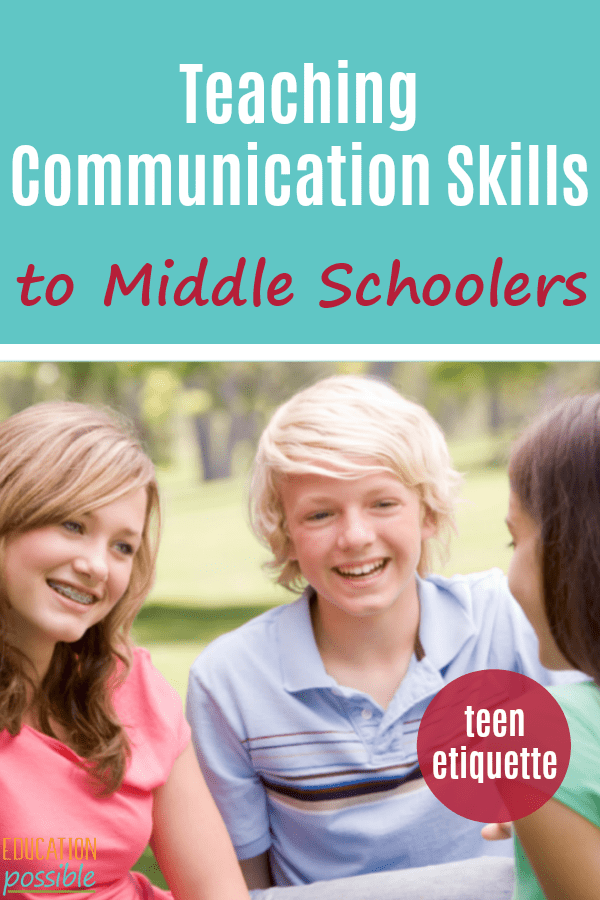Teaching Communication Skills to Middle Schoolers
Teaching communication skills to middle school students should be a regular part of your life skills lesson plans.
Since the goal for us all is to raise confident kids who go on to be successful adults, we must make time to teach them everything they need to know in order to move out on their own.
As homeschoolers, we are fortunate that we can work on these things as a part of our regular school day. Even with this flexibility, it can be challenging trying to figure out what exactly they need to learn.
Effective communication is definitely a skill that all tweens should start mastering. This is something that I consider a non-negotiable in our house and an area we’ve spent a lot of time practicing.
Kids who can’t communicate effectively often become adults who struggle to express themselves properly, which puts them at a disadvantage.
That’s why communication skills should be at the top of your list.
Any links in this post may be affiliate links. See my disclosure statement.
Teaching Communication Skills to Middle School Students
With older kids, it’s important that you continuously cultivate their social skills, including communication.
Historically, successful leaders in industry and government, like Abraham Lincoln, Abigail Adams, and Martin Luther King Jr., have been effective communicators. It’s one of those skills that is extremely nuanced and takes a lot of practice to master.
That’s why in our etiquette club, our middle school students have been learning how to communicate with each other.
Yes, we are a part of an etiquette club.
We use Etiquette Intermediate from the Etiquette Factory as the basis for our classes. It contains 125 brief lessons, each designed to teach proper manners and various social skills.
Activities for Students to Improve Communication Skills
During our last semester, I focused on communication skills. I wanted to teach them techniques for communicating effectively with each other and give them scenarios to practice what they were learning.
Two elements that made the lessons effective were definitely role-playing and relevancy.
We spent a lot of our time acting out various scenarios, showing both positive and negative ways of communicating. Because the lessons were interactive, the kids were engaged, which helped them grasp the material.
There were some trip ups too, along with quite a bit of laughing. By giving them a safe space to make mistakes, to try something new, they gained some confidence they’ll need when they’re out in the world, where the stakes are higher.
I also worked hard to show them how they would use everything in a real-life situation. Teens love knowing why they are learning something and how they will use it in the future.
Communication works for those who work at it. ~John Powell
3 Communication Skills for Teens
Communication is a vast subject, so I chose three topics to focus on.
How to Enter and Leave a Conversation
Many teens don’t know how to enter an existing conversation correctly. They either barge right into the conversation or stand uncomfortably to the side.
First, I had our kids take turns being the person trying to join the discussion. They quickly learned that entering a conversation can be awkward.
I taught them that both parties have a role to play. Instead of jumping right in, the person trying to get into a conversation should wait patiently until those who are talking notice them. On the flip side, when you’re talking in a group, keep an eye out for others wanting to join in, and when there’s an opening, invite them in and make introductions.
Armed with this new knowledge, the kids tried it again, finding greater success.
Then it was time to practice politely leaving a conversation.
I secretly told one tween to turn around and leave the discussion without saying a word to anyone. When she left the circle, the rest of the kids stood there trying to figure out what happened.
This was a concrete way for them to see why excusing yourself is the polite way to leave a conversation.
How to Make Small Talk and Why it is Important
Some of our kids love to talk and thrive on in-depth discussions. I wanted them to understand that we can’t have the same level of interaction with everyone. In some situations, small talk is the appropriate form of communication.
We brainstormed common small talk topics (weather, work, current events, hobbies, etc.), discussed topics that you should avoid (politics, religion, and other polarizing topics), and why successful communicators stay away from these topics.
Then the teens spent some time walking around, making small talk with each other. When they were finished, everyone shared positives and negatives from the experience. This gave them the chance to hear what worked for the person they were communicating with and where they could improve.
Everyone came up with alternative things the person could have said or different directions they could take the conversation next time.
By offering feedback, the kids knew that when they encountered a situation where they had to make small talk, they would understand what to do.
How to Read Body Language and Adapt
In our group, we have kids who love to hear themselves talk and could chat for hours on a particular subject. Unfortunately, neither of these leads to a good dialogue.
Teens need to learn that a conversation is about give and take.
During our role-playing, I instructed one person to monopolize the conversation and someone else to use body language to show that they weren’t really interested or listening.
Kids rarely notice when others check out of their discussions, but by observing others, it was easier for them to recognize when conversations weren’t working.
Together, the kids talked about how they could make changes when they noticed it was becoming a one-way conversation. Their ideas included asking the other person some questions, starting a new topic, or even ending the talk.

Social skills, specifically communication skills, take time to develop and require a lot of practice, so it’s important to begin working with your kids as early as you can.
Personally, I love using Etiquette Intermediate because it gives me a solid place to start. It provides a fun story for the kids to read aloud and leaves me enough flexibility to make the lessons unique.
Additional Teen Etiquette Ideas
- See why you don’t need socialization to teach social skills.
- Are table manners for teens a part of your lessons?
- Discover why it’s important to teach our teens proper etiquette.
- Make sure your tweens know proper etiquette when visiting a friend’s house.
Resources for Teaching Communication Skills
- Teaching Social Skills Through Sketch Comedy and Improv Games
- Communication Skills for Teens: How to Listen, Express, and Connect for Success
- The Etiquette Factory



This looks like a great resource!! 🙂
We’ve really enjoyed it Eva. It’s led to a ton of great, useful conversations about real live situations the kids will experience. I know for Marianna, walking through things before she experiences them (and giving her ideas for handling them) is very useful.
I have been looking for an age appropriate communications-type course for my “shy” middle school boys, this looks perfect! Thanks so much!
I hope you find it as useful as we do Shelley. I love that the lessons are short enough on their own that the kids aren’t bored and I can add in some fun “real life” experiences as well.
Love this idea!!!
Thank you Heather! I wasn’t sure about doing “etiquette” with my older kids, but it has been an amazing experience. We have such fun discussions about how what they are learning will help them with their careers. They love hearing about real life examples of how they will use it.